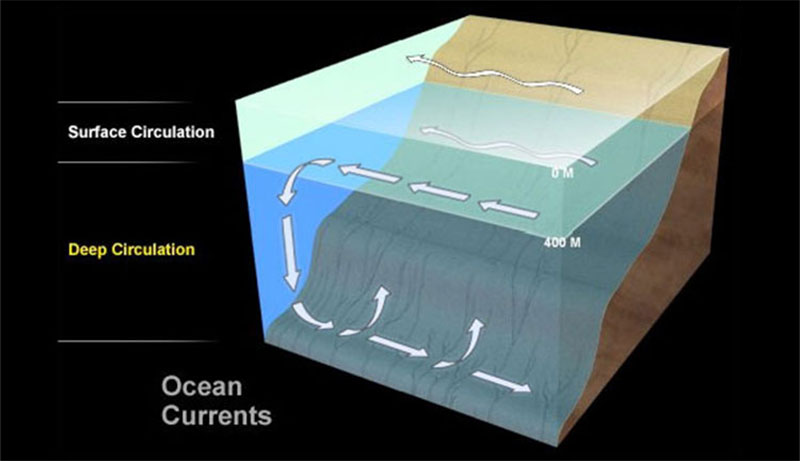Describe How Density Affects the Flow of Deep Currents
The surface current can be found in the upper 400 meters in the water. Large and fast-moving turbidity currents can incise and erode continental margins and cause damage to artificial structures such as telecommunication cables on the seafloorUnderstanding where turbidity currents flow on the ocean floor can help to decrease the amount of damage to telecommunication cables by avoiding these areas or reinforcing the.

What Causes Ocean Currents Ocean Exploration Facts Noaa Office Of Ocean Exploration And Research
Dense water sinks below less dense water.

. Density currents in nature are exemplified by those currents that flow along the bottom of oceans or lakes. The density of sea water varies globally due to differences in temperature and salinity. When salty water sinks deeper through the water column because of its greater density deep ocean currents are formed as the water moves horizontally and travels from areas of high salinity to those that are less salty.
List the factors that affect the density of ocean water. A combination of high salinity and low temperature near the surface makes seawater dense enough to sink into the deep ocean and flow along the bottom of the basins. Find out more in this article Ocean motion.
So thermohaline circulation is the result of density differences in water masses because of their different temperature and salinity. Surface currents 1. Learn deep currents with free interactive flashcards.
Haline salinity in the deep ocean and wind-driven currents on the surface. There are two types of ocean currents which are surface currents and deepwater currents. Differences in temperature and in salinity change the density of seawater.
Its possible for a current to be slow moving too at an average speed of 2 kmhr. The greater number of molecules in the cold water makes the water denser than warm water so it will sink to the bottom mixing with the warmer water. A combination of high salinity and low temperature near the surface makes seawater dense enough to sink into the deep ocean and flow along the bottom of the basins.
They create a circular pattern and the convection creates the water. The surface current is equal to 10 of all water in the ocean. These deep-ocean currents are driven by differences in the waters density which is controlled by temperature thermo and salinity haline.
List three major surface currents and two major deep currents. Cold deep ocean water is often much higher in essential mineral nutrients than surface waters because as organisms die they sink and take their minerals with. They combinely create density differences that causes deep water currents to the flow.
As a consequence it sinks and flows along the bottom under the effect of gravity. The hot and lower density water moves upward and the cold and denser water moves downward. Such subaqueous currents occur because some of the water in an ocean or lake is colder or saltier or contains more suspended sediment and thus is denser than the surrounding waters.
Choose from 106 different sets of deep currents flashcards on Quizlet. Movement of polar waters. This process is known as thermohaline circulation.
Deep ocean currents also known as Thermohaline Circulation are caused by. After this mixing occurs the higher density water sits along the bottom and the lower density water has risen to the top. Dense water sinks below less dense water.
This process is known as thermohaline circulation. DENSITY CURRENTS Overview This activity demonstrates the Thermohaline Circulation throughout the worlds oceans and the relative density between cold and warm ocean water. Cold salty water is dense and sinks to the bottom of the ocean while warm water is less dense and remains on the surface.
Deep ocean currents Differences in water density resulting from the variability of water temperature thermo and salinity haline also cause ocean currents. The earths rotation also influences deep ocean currents. This particular bullet point will explain the surface current first.
This motion is caused by a combination of thermohaline currents thermo temperature. This is the principle that drives the deep ocean currents that circulate around the world. This is the principle that drives the deep ocean currents that circulate around the world.
Describe How Density Affects The Flow Of Deep Currents. A density current is where a warm current floats on top of a cold currentA density current is where a warm current floats on top of a cold currentThe movement of a mass of cold dense ocean water. This process is known as thermohaline circulation.
Water density salinity differences tides temperatures and Orison Effect that is caused by earths rotation drive the ocean currents but wind specifically plays a major role in the movement and direction of the currents. Surface water is heated by the sun and warm water is less dense than cold water. Thermohaline circulation drives deep ocean circulation.
This process is known as thermohaline circulation. Describe how density affects the flow of deep currents. Identify the winds that affect the surface current on either side of the equator.
The temperature and the salt concentration combinely changes the density of the water. Effect on ocean floor.

Ocean Currents The Reality Of Sending A Message In A Bottle Ppt Download

Deep Currents Ck 12 Foundation

Climate Connection Global Conveyor Belt Manoa Hawaii Edu Exploringourfluidearth
No comments for "Describe How Density Affects the Flow of Deep Currents"
Post a Comment